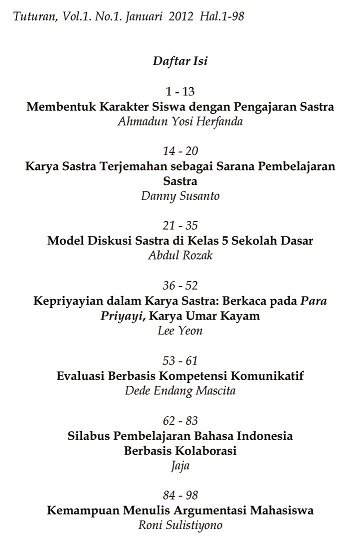MODEL DISKUSI SASTRA DI KELAS 5 SEKOLAH DASAR (Studi Pengembangan Pembelajaran Sastra di Sekolah Dasar Negeri Cirebon)
DOI:
https://doi.org/10.33603/jt.v1i1.1088Keywords:
respons, pengalaman bersastra, apresiasi, diskusi, kolaborasi, kompetensi sastra, model, teks sastraAbstract
The writer considers the opportunities given by curriculum, the teachers’ potential to conduct literature learning well, the students’ potential as reader that could be developed and be given opportunities to explore he texts, and he potential of literature itself which is multi-interpreted. Based on those considerations, the writer integrates those opportunities and potential into a model of literature discussion.
Based on the data analysis, the writer finds that: 1) the students get literature competence after they carry out activities that occupy them with literature. 2) The students could create events based on the text they read. 3) The students’ creativity is shown when they dramatize the events. 4) This model involves the four language skills. 5) The students use their knowledge on literature they get when they response. 6) Discussion on literature at elementary schools takes place in the form of question and answer.References
Abrams, M.H. (1971). A Glossary of Literary Terms. New York : Hold, Rinehart and Winston, Inc.
Aebersold, J.A. & Filed, M.L. (1997). From Reader to Reading Teacher: Issuess and Strategies for Second Language Classrooms. Cambridge University Press.
Allan, A. D.F. (1992). Potrtolio Assessment. New York; Toronto; London; Scolastic Professional Books.
Analia, A., Mariela, C., Alicia, M. & Evelyn. (tanpa tahun). Children’s Literature in the English Classroom. di http://www.shareeducation.com.ar/ TESINAS/Childrenliterature.htm. 07/02/05
Arikunto, S. (1989). Manajemen Penelitian. Jakarta: Departemen Pendidikan dan Kebudayaan, Direktorat Jenderal Pendidikan Tinggi
Badger, E. & Thomas, B. (1992). Open-Ended Questions in Reading. http://ericae. net/pare/getvn.asp?v=3&n=4
Beach, R.W. & Marshall, J.D. (1991). Teaching Literature in the Secondary School. London, New York, Tokyo, Toronto : Harcourt Brace Jovanovich, Publishers
Brooks, J.G. & Brooks, M.G. (1999). The Case for Contructivist Classroom. Alexandria, Virginia USA ; Association for Supervision and Curriculum Development
Brophy, J. (tanpa tahun). Teaching. Educational Practices Series-1
Carter R. & Long, M.N. (1996). Teaching Literature. Longman.
Carter, R.& Mc.Rae, J. (1996). Language, Literature, and The Learner. London : Longman.
Caughan, S. (2004). Classroom Discussion : Teachers’ Perspective on Obstacles and Strategies. http://cela.albany.edu/newslet/fall01/caughlin.htm 27/10/04
Conry C.E. (1977). A Student Teacher’s Experiences Structuring Literature-Based Discussion. National Council of Teachers of English.
Damono, S.D. “Ke Mana Perkembangan Sastra Kita?†dalam Forum Bahasa, 26 November 2002.
Dietz, D. T. (1978) “An Alternative Approach to The Teaching of Literature†ADFL Bulletin, September 1978, No. 1.
Elkins, D. (1976). Teaching Literature:Designs for Cognitive Development. Ohio : Charles E. Merril Publishing Company
Galda, L.& Beach, R. (2001). “Response to Literature†(Reading Research Quartely, Vol. 36, No. 1 January/February/March 2001). International Reading Assication.
Herman, Ashbacher, & Winters (1992). Select or Design Assessment that Elicit Estabished Outcomes. Tersedia pada http:/www.ncrel.org/sdrs/areas/issues/methods/assment/as7sele2.htm 19/3/2002
Iser, W. (1980). The Act of Reading. Baltimore: The John Hopkins University Press.
Jocye, B. & Weil, M. (2000). Models of Teaching. New Jersey : Prentice-Hall Inc.
Langer,J. A. (1994). Process of Understanding Literature: An 8-Year Study http://cela.albany.edu/process/main.html
Marshall, J.D., Smagorinsky, P. & Smith, M.W. (1995). The Language and Interpretation: Patterns of Discourse in Discussions of Literature. NCTE Research Report No.27
Moody, H.L.B. (1971). The Teaching of Literatuer. Longman.
Parkinson, M. (2003). Structured Discussion Overview. Tersedia pada http:/odtl.dcu .ie/project/Structured_discussion?Structured Discussion Overview3.doc 08/09/03
Probst, R.E. (1990). “Literature as Exploration and the Classroom†dalam Transactions with Literature. Edmund, J.F. & Jmaes, R.S. (penyunting)). Urbana, IL : NCTE.
Rosenblatt, L.M. (1978). The Reader, the Text, The Poem. Carbordale, IL : SIUP.
Rosenblatt, L.M. (1988). Writing and Reading : The Transactional Theory. Technical Report N. 13. University of California, Berkeley CA 94720
Rusyana, Y. (2002). Peta Konsep Kesastraan. Pusat Perbukuan, Departemen Pendidikan Nasional.
Downloads
Published
Issue
Section
Citation Check
License
The Authors submitting a manuscript do so on the understanding that if accepted for publication, copyright of the article shall be assigned to Jurnal Tuturan, Sekolah Pascasarjana Pendidikan Bahasa. Universitas Swadaya Gunung Jati as publisher of the journal. Copyright encompasses rights to reproduce and deliver the article in all form and media, including reprints, photographs, microfilms, and any other similar reproductions, as well as translations.
Jurnal Tuturan, Universitas Swadaya Gunung Jati and the Editors make every effort to ensure that no wrong or misleading data, opinions or statements be published in the journal. In any way, the contents of the articles and advertisements published in Jurnal Tuturan are the sole responsibility of their respective authors and advertisers.









